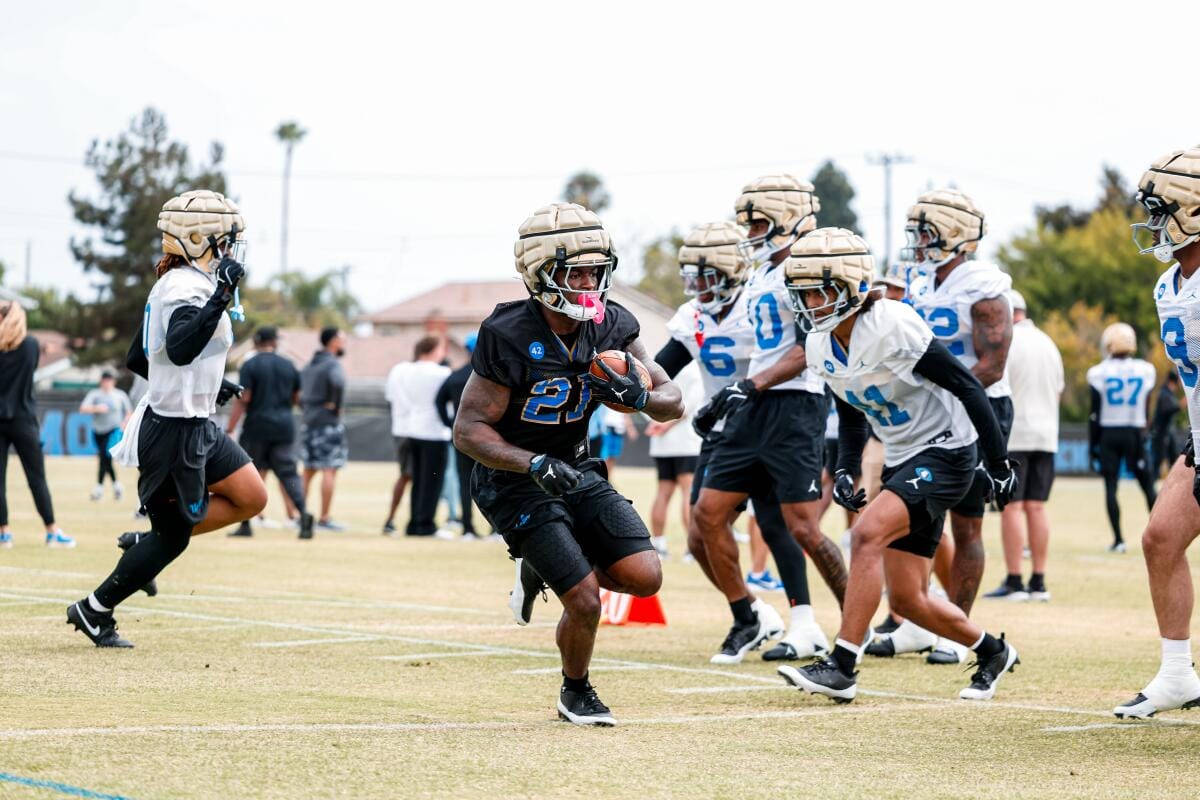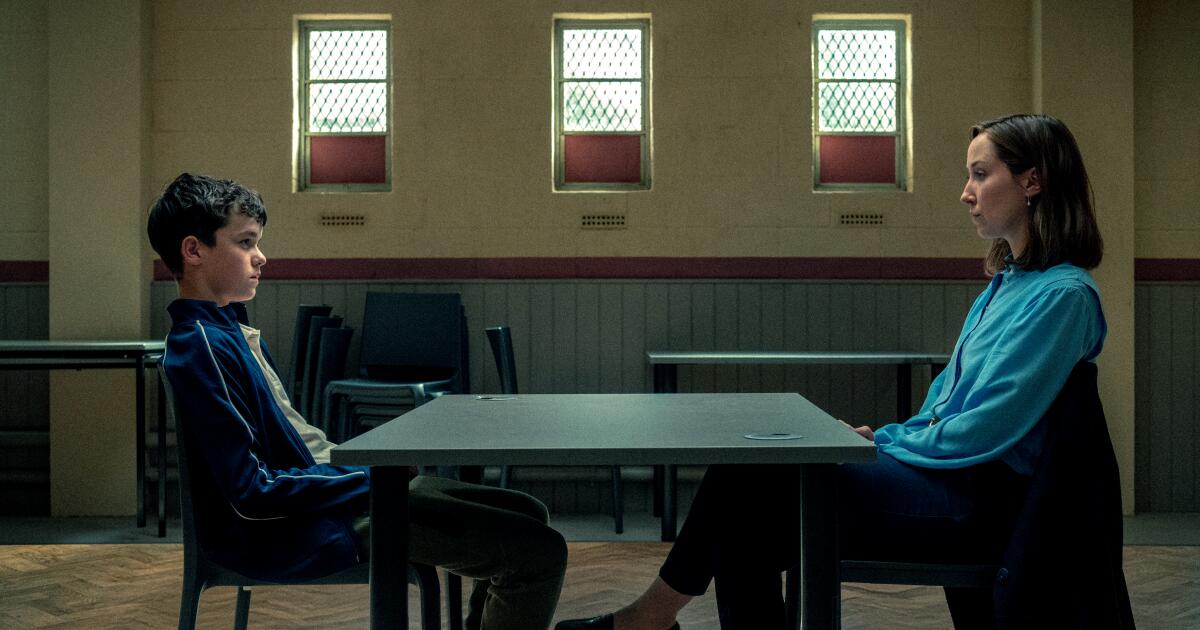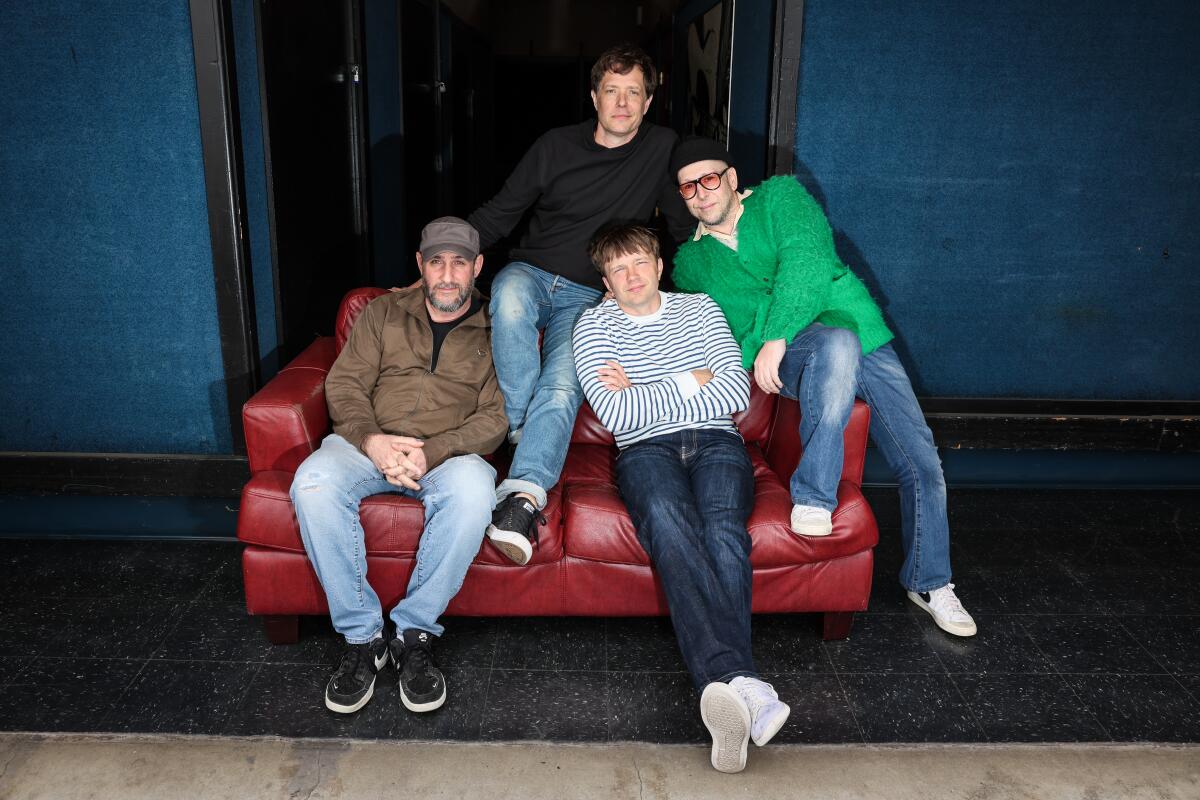UCLA’s Tino Sunseri vying to make child’s play out of winning
Tino Sunseri is spending the next two weeks in Costa Mesa while a large chunk of his heart resides on the East Coast.
That’s where the new UCLA offensive coordinator’s wife and 3-month-old son are living with one set of grandparents, allowing Tino to focus the best he can on training camp with the Bruins.
The first-time father is buoyed both by what he’s seeing with his team and reports about his infant, who giggled for the first time the other day. Santino Michael Sunseri Jr. already has a nickname — “We’re calling him Sonny, like ‘The Godfather,’ ” Tino cracked, referring to Santino “Sonny” Corleone from the movie — and curiously studies his father in FaceTime sessions.
“Right now,” Tino said Saturday morning, “he’s kind of giving me that look, like, ‘Hey, I know your voice, but who are you right here?’”
There’s also plenty of getting to know you between Sunseri and his new quarterback.
Nico Iamaleava enrolled in June after transferring from Tennessee, making this the fifth consecutive season that Sunseri will be working with a new quarterback. In 2021, Sunseri’s first season as quarterbacks coach at James Madison, veteran quarterback Cole Johnson led the Dukes to the semifinals of the Division I-AA playoffs.
A year later, Sunseri worked with Todd Centeio, a transfer from Colorado State who led James Madison to the Sun Belt Conference’s East Division title. In 2023, Sunseri and Jordan McCloud, a transfer from Arizona, helped the Dukes notch another division title.
Last season might have been Sunseri’s most impressive working with a newbie quarterback. Kurtis Rourke, a transfer from Ohio, led Indiana to a historic season that included an 11-2 record and appearance in the College Football Playoff.
Sunseri’s first impressions of Iamaleava align with the sort of immediate success he’s enjoyed with other quarterbacks.
“He’s a self-driven person,” Sunseri said. “He has a certain standard of how he wants to be able to operate each day. And the great thing about my past is I’ve been around a lot of guys that have the same kind of feel and thought process.
“So the only thing you’ve got to do with these guys is you’ve got to be able to give them the information, and you’ve got to keep being able to stimulate them to be able to make sure that every single day, there’s something that they’re being able to attack and chase, and there’s not one day that he hasn’t come in here that he’s not focused on being able to become the best player that he can be for UCLA.”
In the limited media viewing period Saturday, Iamaleava had more success on the ground than through the air, faking a handoff and cutting to his right for a touchdown run. The only pass he threw, intended for Ezavier Staples, was broken up by defensive back Jamir Benjamin in the end zone.
Iamaleava has impressed Sunseri with a relentless approach — whenever he’s not practicing or working out, he’s studying the offense.
“It’s infectious to him; he can’t get enough of it,” Sunseri said. “And when you have those kind of guys, you can start to be able to see how they can be able to develop, and now you can be able to start to be able to formulate a mindset and starting to be able to see where they think, how they think and start to be able to have it to where you can really understand how to coach them.”
Having such a condensed window to work with Iamaleava before the season opener against Utah on Aug. 30 at the Rose Bowl isn’t a concern to Sunseri.
“It’s not about us being able to install the offense,” Sunseri said, “it’s about being able to make sure that it’s not too much too fast to where he can be able to grasp it, because we’re not playing next week, we’re playing in three weeks — it’s still a ton of time for us to be able to utilize.”
Those wondering what UCLA’s offense will look like might have to wait until the season opener because Sunseri isn’t divulging much besides its goal to stretch a defense so that it must account for “every single blade of grass.” Sunseri did suggest that there will be an ample amount of running the football.
“Let me say this: We’re gonna be a physical football team,” said Sunseri, whose first coaching stops came as a quality control coach at Florida State and Tennessee and a graduate assistant at Alabama. “It’s where I’ve always been raised, coming from the SEC, you’ve got to run that ball, and me being a Nick Saban disciple, that’s just my thought process, right?”
A speedy duo
UCLA running back Jaivian Thomas carries the ball during preseason training in Costa Mesa on Friday.
(Nate Donlevy / UCLA Athletics)
Jaivian Thomas, the transfer running back from California, is so fast that his father called him “The Jet” growing up.
During informal sprints with his new team, Thomas said fellow running back Anthony Woods stayed with him step for step.
So does that make this a twin-jet offense?
“Ant got gas,” Thomas said of his teammate, “but I feel like I’m the fastest in the room.”
The hope is that alongside returners Jalen Berger and Anthony Frias II, the Bruins can spread their carries and wear down defenses. While Thomas and Woods are the speedsters of the group, Berger and Frias might feature slightly more power to their rushing styles.
Berger said he had fully recovered from the sprained ankle he suffered against Iowa last season that hindered him over the season’s final four games. Thomas was the Golden Bears’ leading rusher last season, averaging 6.3 yards per carry while gaining 644 yards and scoring seven touchdowns.
Coach DeShaun Foster called Thomas a threat to score every time he touched the ball. If all goes as planned, multiple running backs will cross the goal line while challenging defenses.
“It allows those guys to be able to stay fresh, and as those defenses align, they’re playing 40, 50, 60 snaps in the game, and you’re getting to the fourth quarter, those guys are a little worn out,” Sunseri said of playing a bevy of running backs. “So then whenever you put a guy in with fresh tires, then he could be able to have it to where he’s running through a couple of those tackles, maybe he’s able to continue to be able to play at a different speed than those [defensive] guys in the game.”





